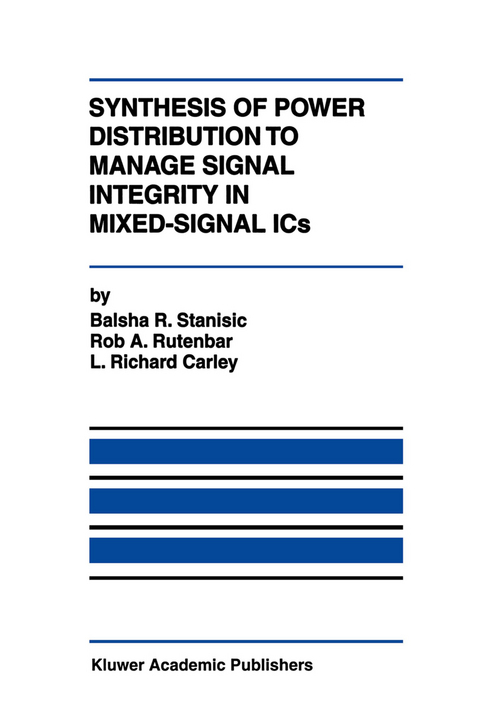
Synthesis of Power Distribution to Manage Signal Integrity in Mixed-Signal ICs
Springer-Verlag New York Inc.
978-1-4612-8606-6 (ISBN)
1 Introduction.- 1.1 Focus.- 1.2 Motivation.- 1.3 Research Overview.- 1.4 Preview of Results.- 1.5 Book Organization.- 2 Power Distribution Noise and Physical Design Methods.- 2.1 Analog Design Problem Characteristics.- 2.2 Design Style Concerns.- 2.3 Analog Power Distribution Design Concerns.- 2.4 Previous Research in Power Distribution Synthesis.- 2.5 Critical Analysis.- 2.6 Concluding Remarks.- 3 Physical Design and Optimization.- 3.1 New Optimization-based Strategy.- 3.2 Design Style Selection.- 3.3 Power Bus Topology Selection and Sizing.- 3.4 Power I/O Cell Assignment.- 3.5 Simultaneous Power Bus and I/O Cell Optimization.- 3.6 Review of Simulated Annealing.- 3.7 Simulated Annealing Formulation.- 3.8 Concluding Remarks.- 4 DC, AC, and Transient Electrical Models and Analysis.- 4.1 Electrical Formulation Objectives.- 4.2 Mapping Power Bus and I/O Cell Geometry to Electricity.- 4.3 Modeling Macrocells.- 4.4 Modeling Interconnect.- 4.5 Modeling Chip Substrate.- 4.6 DC Behavior Evaluation Methods.- 4.7 AC and Transient Behavior Evaluation Methods.- 4.8 Review of Asymptotic Waveform Evaluation (AWE).- 4.9 AWE-based Single Input Switching Behavior.- 4.10 AWE-based Simultaneous Switching Behavior.- 4.11 Concluding Remarks.- 5 Experimental Results.- 5.1 Experimental Plan.- 5.2 Example Nonconvex.- 5.3 Example Analog 1.- 5.4 Example Mixed-Signal1.- 5.5 Example Mixed-Signal2.- 5.6 Example Mixed-Signal3.- 5.7 Example Config 1.- 5.8 Example Stanford.- 5.9 Example Mixed-Signal4.- 5.10 Example CMU.- 5.11 SQP and Annealing, Revisited.- 5.12 Concluding Remarks.- 6 Conclusions.- 6.1 Summary.- 6.2 Contributions.- 6.3 Future Directions.- A Symbolic Convolution of Special Waveforms.- A.1 Specialized Waveforms.- A.1.1 Trap.- A.1.2. Sinsq.- A.2 Fundamental Waveforms.- A.2.1 Step.- A.2.2Ramp.- A.2.3 Cosine.- B Circuit Element Approximation of Chip Substrate.- B.1 Underlying Treatment.- B.2 General Bulk Field Derivation.- B.3 Box Integration.
| Zusatzinfo | XXII, 208 p. |
|---|---|
| Verlagsort | New York, NY |
| Sprache | englisch |
| Maße | 155 x 235 mm |
| Themenwelt | Informatik ► Weitere Themen ► CAD-Programme |
| Technik ► Elektrotechnik / Energietechnik | |
| ISBN-10 | 1-4612-8606-9 / 1461286069 |
| ISBN-13 | 978-1-4612-8606-6 / 9781461286066 |
| Zustand | Neuware |
| Haben Sie eine Frage zum Produkt? |
aus dem Bereich


